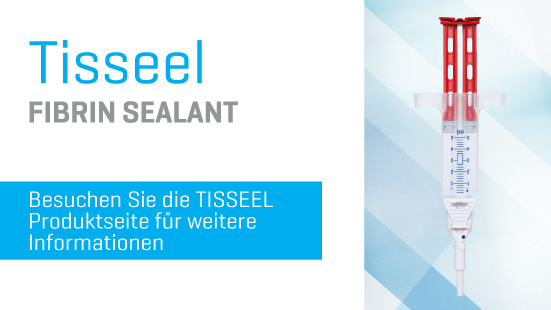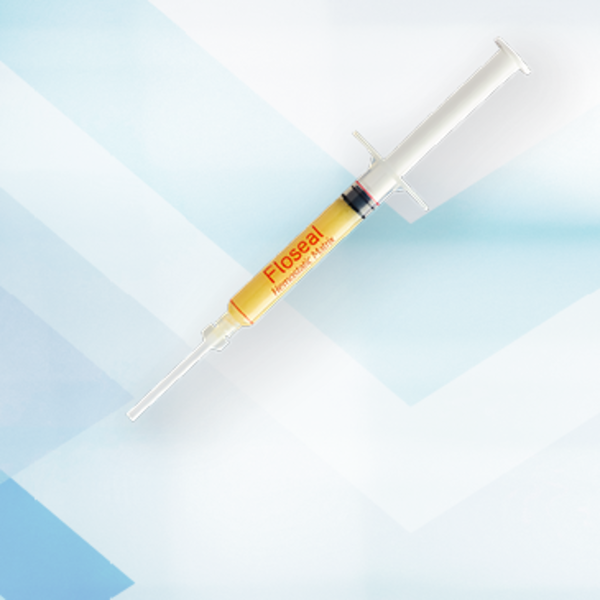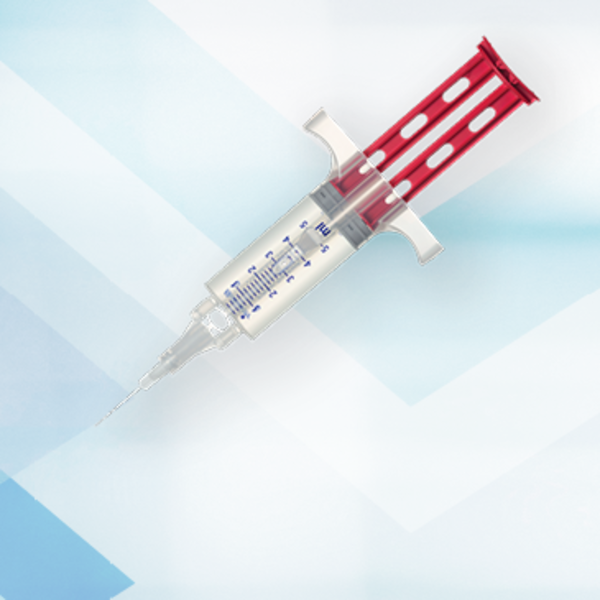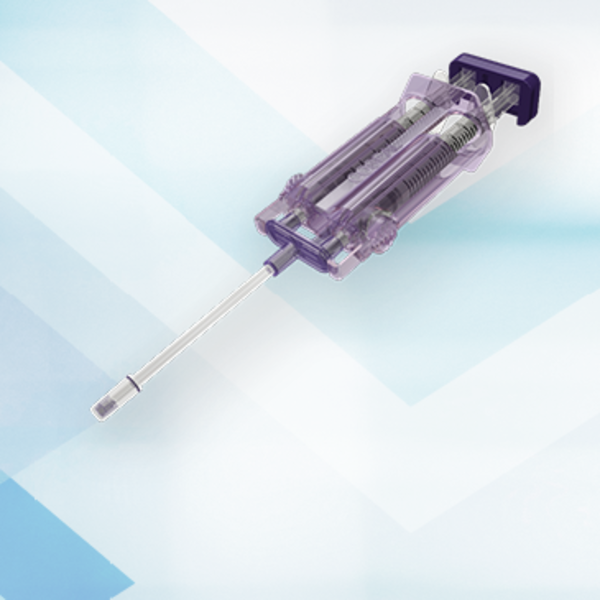Gynecological Surgery
Gynecological surgery not only requires control of bleeding and oozing across broad surfaces, but also requires physicians to maintain fertility in many of their patients. Baxter's hemostats and sealants help patients heal faster and with fewer complications, while Baxter's instillant helps address post-operative adhesions.
Each gynecological procedure presents unique challenges that can cause complications for the healing process. Here are a few examples.

Hysterectomy
With hysterectomy procedures, the ability to control both routine and unexpected bleeding is crucial. FLOSEAL, Baxter's flowable hemostat, provides fast hemostasis (2 minutes median time to hemostasis) that stops many different types of bleeding1.

Myomectomy
Bleeding during and/or after a myomectomy can lead to more severe complications such as a return to the operating room or worse yet, a hysterectomy. TISSEEL, Baxter's fibrin sealant, has a wide range of drip and spray applicators and mimics a physiological clot for resorption in 7-14 days2.
Gynecologic Laparoscopy
COSEAL Surgical Sealant is a fully synthetic resorbable hydrogel, designed to provide a rapid intraoperative seal and to maintain protection during the critical postoperative period.3
ADEPT® Adhesion Reduction Solution is a non-viscous, colorless liquid that contains 4% icodextrin. The solution provides broad coverage, temporary tissue separation, and serves as an irrigant throughout surgery.4
Portfolio of Products
Indications and Important Risk Information
FLOSEAL Hemostatic Matrix Indication
FLOSEAL is indicated in surgical procedures as an adjunct to hemostasis when control of bleeding, ranging from oozing to spurting, by ligature or conventional procedures is ineffective or impractical.
Contraindications
Do not use FLOSEAL in patients with known allergies to materials of bovine origin.
Warnings
Do not inject or compress FLOSEAL into blood vessels.
Do not apply FLOSEAL in the absence of active blood flow, e.g., while the vessel is clamped or bypassed. Extensive intravascular clotting and even death may result.
FLOSEAL is not intended as a substitute for meticulous surgical technique and the proper application of ligatures or other conventional procedures for hemostasis.
FLOSEAL is not intended to be used as a prophylactic hemostatic agent to prevent postoperative bleeding.
Excess FLOSEAL Matrix (material not incorporated in the hemostatic clot) should always be removed by gentle irrigation from the site of application. Meticulous irrigation is required when used in, around, or in proximity to foramina in bone, areas of bony confine, the spinal cord, the brain and/or cranial nerves.
As with any implantable material, the use of FLOSEAL is not recommended in the presence of an active infection.
FLOSEAL should be used with caution in contaminated areas of the body. If signs of infection or abscess develop where FLOSEAL has been applied, re-operation may be necessary in order to remove the infected material and allow drainage.
Regardless of the type of surgical procedure, surgeons should consider the maximum swell volume of FLOSEAL, which is between 10 – 20%, after product is applied to source of bleeding and its potential effect on the surrounding anatomic areas. Maximum swell volume is achieved within about 10 minutes.
The safety and effectiveness of FLOSEAL for use in ophthalmic procedures has not been established.
FLOSEAL should not be used for controlling intrauterine post-partum bleeding or menorrhagia.
The safety and effectiveness of FLOSEAL has not been established in children and pregnant women.
Do not use FLOSEAL in the closure of skin incisions because it may interfere with the healing of the skin edges due to mechanical interposition of gelatin. The safety and effectiveness of the use of FLOSEAL Matrix as a carrier for antibiotic solutions or powders has not been established.
For safe and proper use of this device, please refer to the Instructions for Use.
CE 0123
TISSEEL Indications and Important Risk Information
This abbreviated summary of product characteristics (SPC) is intended for international use. Please note that it may differ from the licensed SPC in the country where you are practicing.
Therefore, please always consult your country-specific SPC or package leaflet.
TISSEEL
Fibrin Sealant
TISSEEL Lyo – Powders and solvents for sealant
TISSEEL – Solutions for sealant
Composition (after mixing), per 1ml
Component 1 (Sealer protein solution): Human fibrinogen (as clottable protein) 45.5mg, Aprotinin (synthetic) 1500 KIU
Component 2 (Thrombin solution): Human thrombin 250 IU, Calcium chloride 20 μmol
Indications
Supportive treatment where standard surgical techniques appear insufficient
- For improvement of hemostasis
- As a tissue glue to improve wound healing or to support sutures in vascular surgery, in gastrointestinal anastomoses
- For tissue sealing, to improve adhesion of the separated tissue (e.g. tissue flaps, grafts, split skin grafts [mesh grafts]).
The efficacy in fully heparinized patients has been proven.
Contraindications
TISSEEL alone is not indicated for the treatment of massive and brisk arterial or venous bleeding.
TISSEEL is not indicated to replace skin sutures intended to close surgical wound.
TISSEEL must never be applied intravascularly. Intravascular application may result in life-threatening thromboembolic events. TISSEEL must not be applied in case of hypersensitivity to the active substances or to any of the excipients.
Special Warnings and Precautions for Use
For epilesional use only. Do not apply intravascularly. Life threatening thromboembolic complications may occur if the preparation is unintentionally applied intravascularly.
Caution must be used when applying fibrin sealant using pressurized gas. Any application of pressurized gas is associated with a potential risk of air or gas embolism, tissue rupture, or gas entrapment with compression, which may be life-threatening. Apply TISSEEL as a thin layer. Excessive clot thickness may negatively interfere with the product’s efficacy and the wound healing process.
Life-threatening/fatal air or gas embolism has occurred with the use of spray devices employing a pressure regulator to administer fibrin sealants. This event appears to be related to the use of the spray device at higher than recommended pressures and/or in close proximity to the tissue surface. The risk appears to be higher when fibrin sealants are sprayed with air, as compared to CO2 and therefore cannot be excluded with TISSEEL when sprayed in open wound surgery. When applying TISSEEL using a spray device, be sure to use a pressure within the pressure range recommended by the spray device manufacturer. TISSEEL spray application should only be used if it is possible to accurately judge the spray distance as recommended by the manufacturer. Do not spray closer than the recommended distances. When spraying TISSEEL, changes in blood pressure, pulse, oxygen saturation and end tidal CO2 should be monitored because of the possibility of occurrence of air or gas embolism.
TISSEEL must not be used with the Easy Spray/Spray Set system in enclosed body areas.
Before the administration of TISSEEL, care is to be taken that parts of the body outside the designated application area are sufficiently protected/covered to prevent tissue adhesion at undesired sites.
If fibrin sealants are applied in confined spaces, e.g. the brain or the spinal cord, the risk of compressive complications should be taken into account.
To ensure adequate mixing of the sealer protein component and the thrombin component, the first few drops of the product from the application canula should be expelled and discarded immediately before use.
As with any protein-containing product, allergic type hypersensitivity reactions are possible. Intravascular application might increase the likelihood and severity of acute hypersensitivity reactions in susceptible patients.
Hypersensitivity and anaphylactic reactions (also fatal, including anaphylactic shock) have been reported with TISSEEL. Signs of hypersensitivity reactions may include hives, generalized urticaria, tightness of the chest, wheezing, hypotension. If these symptoms occur, the administration must be discontinued immediately and the currently valid standard measures for the treatment of shock are to be taken. Remaining product must be removed from the site of application.
TISSEEL contains a synthetic protein (aprotinin). Even in case of strict local application, there is a risk of anaphylactic reaction linked to the presence of aprotinin. The risk seems to be higher in cases where there was previous exposure, even if it was well tolerated. Therefore any use of aprotinin or aprotinin containing products should be recorded in the patients’ records. As synthetic aprotinin is structurally identical to bovine aprotinin the use of TISSEEL in patients with allergies to bovine proteins should be carefully evaluated. In two retrospective, non-randomized studies in coronary bypass surgery, patients who received fibrin sealant showed a statistically significant increased risk of mortality. While these studies could not provide a causal relationship, the increased risk associated with the use of TISSEEL in these patients cannot be excluded. Therefore, additional care should be taken to avoid inadvertent intravascular administration of this product. Injection into the nasal mucosa must be avoided, as thromboembolic complications may occur in the area of the arteria ophthalmica.
Injecting TISSEEL into tissue carries the risk of local tissue damage.
TISSEEL should only be applied as a thin layer. Excessive clot thickness may negatively interfere with the product’s efficacy and the wound healing process. Polysorbate 80 may cause locally limited skin irritations such as contact dermatitis. Standard measures to prevent infections resulting from the use of medicinal products prepared from human blood or plasma include selection of donors, screening of individual donations and plasma pools for specific markers of infection and the inclusion of effective manufacturing steps for the inactivation/removal of viruses. Despite this, when medicinal products prepared from human blood or plasma are administered, the possibility of transmitting infective agents cannot be totally excluded. This also applies to unknown or emerging viruses or other pathogens. These measures are considered effective for enveloped viruses such as HIV, HBV, and HCV, and for the non-enveloped virus HAV. The measures taken may be of limited value against non-enveloped viruses such as parvovirus B19. Parvovirus B19 infection may be serious for pregnant women (fetal infection) and for individuals with immunodeficiency or increased erythropoiesis (e.g., hemolytic anemia). It is strongly recommended that every time that TISSEEL is administered to the patient, the name and batch number of the product are recorded in order to maintain a link between the patient and the batch of the product. Oxidized cellulose-containing preparations should not be used with TISSEEL.
Undesirable Effects
Hypersensitivity or allergic reactions (which may include but are not limited to angioedema, burning and stinging at the application site, bradycardia, bronchospasm, chills, breathing difficulties, transient erythema (“flushing”), generalized urticaria, headache, hives, hypotension, lethargy, nausea, pruritus, restlessness, tachycardia, tightness of the chest, tingling, vomiting, wheezing) may occur in rare cases in patients treated with fibrin sealants / hemostatics, anaphylactic reactions and anaphylactic shock have included fatal outcomes. In isolated cases, these reactions have progressed to severe anaphylaxis. Such reactions may especially be seen if the preparation is applied repeatedly, or administered to patients known to be hypersensitive to aprotinin or any other constituents of the product. Even if repeated treatment with TISSEEL was well tolerated, a subsequent administration of TISSEEL or systemic administration of aprotinin may result in severe anaphylactic reactions. Antibodies against components of the fibrin sealant / hemostatic may occur in rare cases. Inadvertent intravascular injection may result in thromboembolic events and DIC. Furthermore there is the risk of an anaphylactic reaction. The following adverse reactions have been reported from clinical studies investigating the safety and efficacy of TISSEEL and from post-marketing experience with Baxter Fibrin Sealants:
Very common (>1/10): Seroma
Common (>1/100 to < 1/10): Postoperative wound infection, Sensory disturbance, anxillary vein thrombosis, Rash, Pain in an extremity, Pain, and Increased body temperature.
Uncommon (>1/1,000 to <1/100): fibrin degradation products increased, hypersensitivity reactions, anaphylactic reactions, anaphylactic shock, paresthesia, bronchospasm, wheezing, pruritis, erythema, bradycardia, tachycardia, haematoma (NOS), embolism arterial, cerebral artery embolism, cerebral infarction, dyspnoea, nausea, intestinal obstruction, urticaria, impaired healing, flushing, oedema, angioedema, procedural pain.
Rare ( >1/10,000 to <1/1,000): hypotension
Not known (cannot be estimated from the available data): Air embolism
Class Reactions
Other adverse reactions associated with the fibrin sealant/hemostatic class include: manifestations of hypersensitivity include application site irritation, chest discomfort, chills, headache, lethargy, restlessness, and vomiting.
Method of Administration
The use of TISSEEL is restricted to experienced surgeons who have been trained in the use of TISSEEL. In order to ensure optimal safe use of TISSEEL by spray application the following recommendations should be followed:
Recommended pressure, distance and devices for spray application of TISSEEL:
Open wound Surgery:
Spray set: TISSEEL/ARTISS spray set
Pressure regulator: EasySpray
Recommended distance from target tissue: 10-15 cm
Recommended spray pressure: 1.5-2.0 bar (21.5-28.5 psi).
Laparoscopic/ minimally invasive procedures:
Spray set: n.a.
Applicator tip: Duplospray MIS Applicator
Pressure regulator: Duplospray MIS Regulator
Recommended distance from target tissue: 2-5 cm
Recommended spray pressure: 1.2-1.5 bar (18-22 psi)
When spraying the TISSEEL, changes in blood pressure, pulse, oxygen saturation and end tidal CO2 should be monitored because of the possibility of occurrence of air or gas embolism.
For the application of TISSEEL in enclosed thoracic and abdominal spaces the DuploSpray MIS applicator and regulator system is recommended. Please refer to the instruction manual of the DuploSpray MIS device.
For posology, incompatibilities and interactions, please refer to the full SPC.
Medicinal product subject to medical prescription.
September 2018
Please see the Summary for Product Characteristic (Lyophilized)
Please see the Summary for Product Characteristic (Frozen)
COSEAL Surgical Sealant Indications
COSEAL is indicated for:
- Sealing suture lines along arterial and venous reconstructions
- Enforcement of suture and staple lines in lung resection procedures
- Patients undergoing cardiac surgery to prevent or reduce the incidence, severity and extent of post surgical adhesion formation
- Patients undergoing laparotomy or laparoscopic abdomino-pelvic surgery as an adjunct to good surgical technique intended to reduce the incidence, severity and extent of post surgical adhesion formation
Contraindications:
Do not use COSEAL as a bronchial stump sealant, during bronchial sleeve resections, or for sealing decorticated lung areas.
Do not use COSEAL in procedures in which pleural adhesions are desired.
Warnings:
COSEAL swells up to four times its volume within 24 hours of application and additional swelling occurs as the gel resorbs. Therefore surgeons should consider the maximum swell volume and its possible effect on surrounding anantomic structures potentially sensitive to compression
Rx only: For safe and proper use of this device, please refer to full device Instructions for Use.
CE0123
ADEPT® Adhesion Reduction Solution [4% Icodextrin] Indications
Important Risk Information for ADEPT®
ADEPT® is intended for use as an intraperitoneal instillate for the reduction of adhesions following gynecological laparoscopic surgery, and should be used as the irrigant during the course of that surgery.
ADEPT® is indicated to be used in gynecological laparoscopic surgery of the abdominal-pelvic cavity in adults.
Contraindications
ADEPT® is contraindicated:
- In patients with known or suspected allergy to cornstarch based polymers, icodextrin, maltose or isomaltose intolerance, or in patients with glycogen storage disease.
- In the presence of frank infection (e.g. peritonitis) in the abdomino-pelvic cavity.
- In procedures with laparotomy incision. Serious post-operative wound complications including dehiscence and cutaneous fistula formation have been reported from clinical experience when ADEPT® was used in surgical cases with laparotomy incision.
- In procedures involving bowel resection or repair, or appendectomy. Anastomotic failure, ileus, peritonitis and rare cases of serosal fibrosis following procedures involving bowel resection and instillation of ADEPT® have been reported from clinical experience.
There are rare reports of pleural effusion from clinical experience with ADEPT®. As a possible relationship to the use of ADEPT®, in conjunction with inappropriate fluid monitoring during surgical procedure cannot be ruled out, the volume of ADEPT® instilled should always follow the recommendations of the Instructions for Use.
Self-limited vulvar swelling is a known side-effect of instilling large volumes of fluid into the abdomino-pelvic cavity. Most cases resolve within one week of surgery. When swelling is associated with urinary retention, catheterization may be necessary effects).
Maltose metabolites of icodextrin may interfere with blood glucose measurement in diabetic patients who use rapid blood glucose systems that are not glucose specific.
For safe and proper use of this device, please refer to full Instructions For Use.
CE0123


